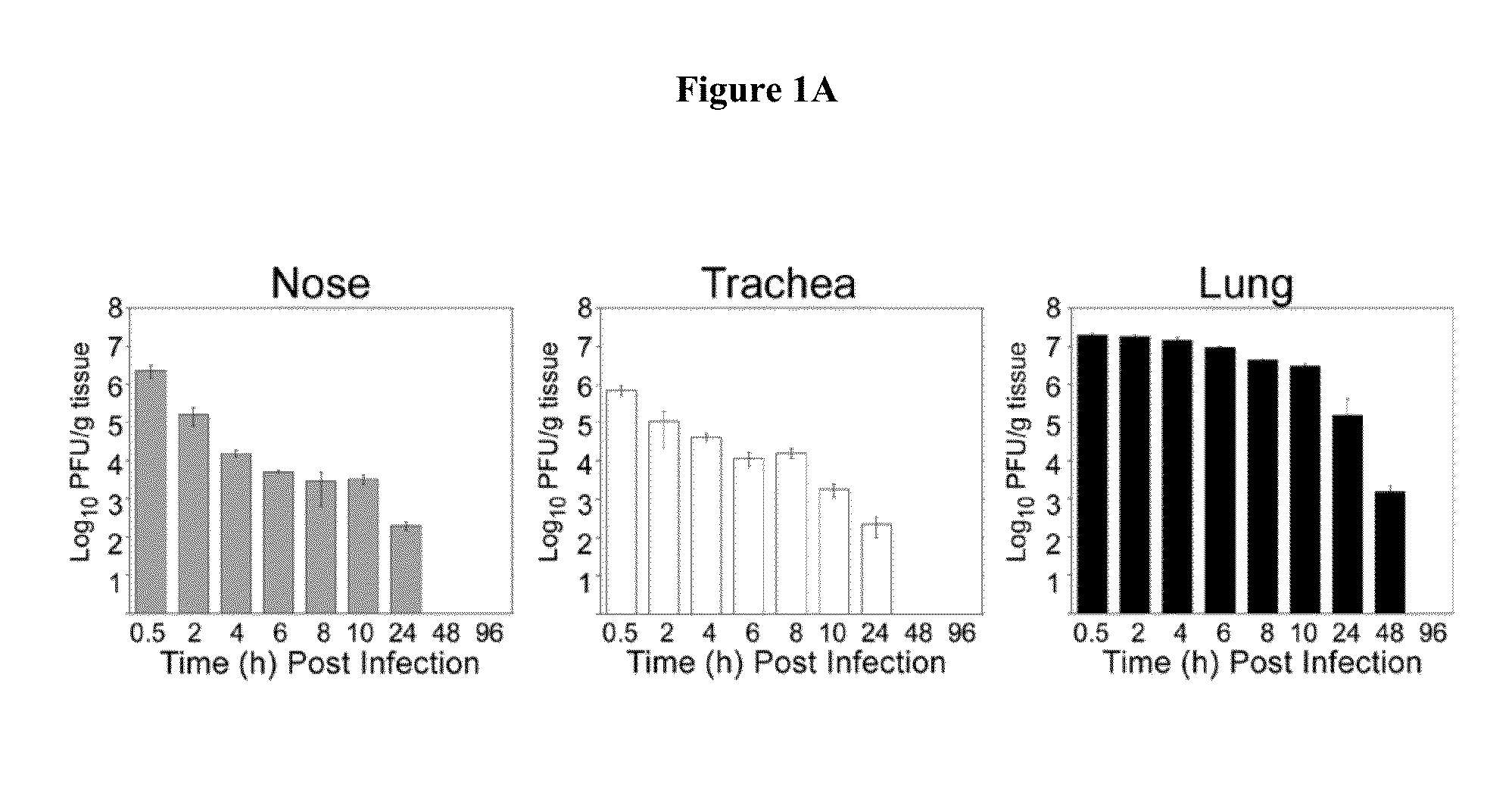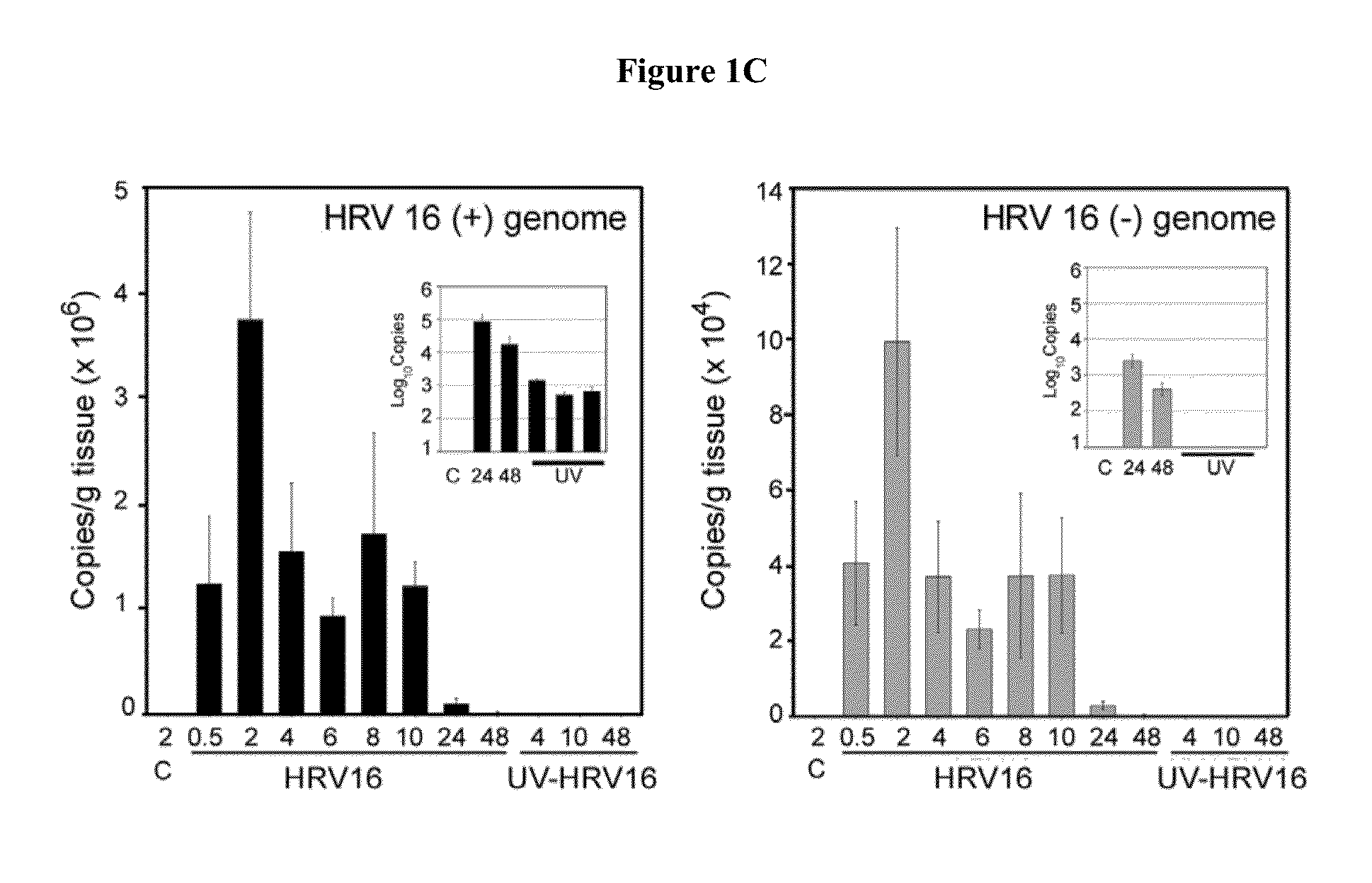Protection against human rhinovirus infection
a technology for rhinovirus and human infection, applied in the field of rhinovirus infection protection, can solve the problems of no rhinovirus vaccine and no hrv-specific antiviral drug currently available, limited value of mouse models, and no human rhinovirus vaccination/challenge/protection studies performed in any animal model,
- Summary
- Abstract
- Description
- Claims
- Application Information
AI Technical Summary
Benefits of technology
Problems solved by technology
Method used
Image
Examples
example 1
Susceptibility of Cotton Rats to Infection with HRV16
[0047]Rationale and Experimental Approach
[0048]Studies were designed to demonstrate that the cotton rat is a permissive host for HRV16 and, therefore, could be used as an animal model for the development of anti-rhinovirus vaccines and therapeutics for the prevention and / or alleviation of rhinovirus-associated respiratory illnesses. Initial efforts focused on the examination of HRV16 infection, replication, and pathogenesis in the cotton rats.
[0049]Materials and Methods
[0050]Virus.
[0051]HRV16 (strain 11757, ATCC cat#VR-283) was obtained from American Type Culture Collection. Virus stocks were produced in HeLa Ohio cells and titered by plaque assay under agarose overlay in monolayers of the same cell line.
[0052]Animals.
[0053]Young adult (4-8 weeks old) cotton rats (Sigmodon hispidus) of both genders were obtained from the inbred colony maintained at Sigmovir Bioystems, Inc (SBI). The animals were housed in large polycarbonate cages...
example 2
Histopathology and Mx Gene Expression in HRV16-Infected Cotton Rats
[0065]Rationale and Experimental Approach
[0066]Studies were designed to characterize pathological changes in cotton rats following infection with HRV16.
[0067]Materials and Methods
[0068]Virus.
[0069]HRV16 and virus stocks were obtained and produced as described above.
[0070]Animals.
[0071]Cotton rats were obtained and maintained as described above.
[0072]Analysis of Mx Gene Expression.
[0073]The assessment of cotton rat Mx-1 and Mx-2 gene expression was carried out as previously described (Pletneva et al., J. Interferon Cytokine Res. 26:914, 2006; Pletneva et al., J. Gen. Virol. 89:261, 2008).
[0074]Statistical Analysis.
[0075]Analysis was performed as described above.
[0076]Results
[0077]Analysis of the pathology associated with HRV16 infection was performed in nose, trachea, and lung using conventional H&E stain and Alcian blue-PAS staining for mucus detection. Lesions were graded on a 5-point scale (0=absent, 1=minimal, 2=m...
example 3
HRV16 Immunity in Cotton Rats
[0082]Rationale and Experimental Approach
[0083]Studies were designed to examine the ability to vaccinate cotton rats against HRV16 infection.
[0084]Materials and Methods
[0085]Virus.
[0086]HRV1B (ATCC cat#VR-1645) and HRV16 (strain 11757, ATCC cat#VR-283) were obtained from ATCC. Virus stocks were produced in HeLa Ohio cells and titered by plaque assay under agarose overlay in monolayers of the same cell line.
[0087]Animals.
[0088]Cotton rats were obtained and maintained as described above.
[0090]Neutralizing antibody titers were determined by a plaque-reduction neutralization assay as described above.
[0091]Statistical Analysis.
[0092]Analysis was performed as described above.
[0093]Results
[0094]Intramuscular (i.m.) vaccination with live HRV16 at a dose of 107 PFU in a priming (day 0) and boosting (day 21) schedule induced the development of high levels of serum neutralizing antibody in cotton rats when measured on day 42 post-priming (FIG. ...
PUM
 Login to View More
Login to View More Abstract
Description
Claims
Application Information
 Login to View More
Login to View More - R&D Engineer
- R&D Manager
- IP Professional
- Industry Leading Data Capabilities
- Powerful AI technology
- Patent DNA Extraction
Browse by: Latest US Patents, China's latest patents, Technical Efficacy Thesaurus, Application Domain, Technology Topic, Popular Technical Reports.
© 2024 PatSnap. All rights reserved.Legal|Privacy policy|Modern Slavery Act Transparency Statement|Sitemap|About US| Contact US: help@patsnap.com










